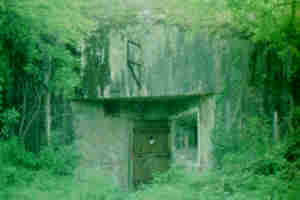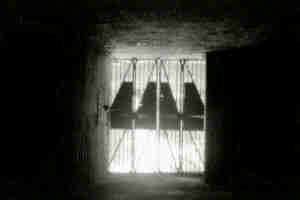

After World War II, when France regained control of her
Eastern frontier, the army began to refurbish some of the Maginot
Line fortifications. In the late 1940s and 1950s, some of the
weapons were upgraded, ventilation was modernized to protect against
nuclear attack, and security was enhanced. In the early 1960s, President
DeGaulle decided to pull France out of NATO and rely on nuclear
weapons as a deterrent against attack by the Soviet Union. With
that, the need for the fortifications lessened. In the late 1960s, France
decided to auction off parts of the line. (Some of the buyers were
Germans). Casemates became storage rooms for farmers; some of the
forts became mushroom farms; some had houses built on top of them.
Many, however, were taken apart by metal salvagers. Steel cupolas
were sliced off and anything that moved that was metal was taken
out of the forts. Many other forts were abandoned to the elements.
 Thanks to some organizations, however, several forts were saved and
can be visited. Groups like "Les Amis de la Ligne Maginot en
Alsace," "Le Tiburce" (SEE
Ouvrage Immerhof)
"Amifort" and some local communities have restored the large forts of Hackenberg, Simserhof,
Fermont, Four a Chaux, and Schoenenbourg, and some smaller sites
like Immerhof, Bambesch, the shelters of Zeiterholz and Graserloch,
and the casemate of Markolsheim. If not for the efforts of these
organizations, the Maginot Line and a great epoch of French history
might be forgotten. Several hundred thousand visitors to these
forts each year attests to the interest that the Maginot Line still
holds.
Thanks to some organizations, however, several forts were saved and
can be visited. Groups like "Les Amis de la Ligne Maginot en
Alsace," "Le Tiburce" (SEE
Ouvrage Immerhof)
"Amifort" and some local communities have restored the large forts of Hackenberg, Simserhof,
Fermont, Four a Chaux, and Schoenenbourg, and some smaller sites
like Immerhof, Bambesch, the shelters of Zeiterholz and Graserloch,
and the casemate of Markolsheim. If not for the efforts of these
organizations, the Maginot Line and a great epoch of French history
might be forgotten. Several hundred thousand visitors to these
forts each year attests to the interest that the Maginot Line still
holds.
 Many forts, however, have been forgotten, except by the weekend
explorer who is brave enough to plunge into their dark depths. I
am one of those explorers and I have seen many fascinating things
in each of the ouvrages I have entered. Today there is nothing but
dead silence and the occasional dripping of water in the tunnels
where men once shouted, engines hummed, and the deafening blast of the
guns echoed throughout the galleries. Where proud and highly
trained men trained for victory, but instead marched off into captivity.
Many forts, however, have been forgotten, except by the weekend
explorer who is brave enough to plunge into their dark depths. I
am one of those explorers and I have seen many fascinating things
in each of the ouvrages I have entered. Today there is nothing but
dead silence and the occasional dripping of water in the tunnels
where men once shouted, engines hummed, and the deafening blast of the
guns echoed throughout the galleries. Where proud and highly
trained men trained for victory, but instead marched off into captivity.
As an explorer and one who loves history, I give the greatest thanks to these organizations who have kept history alive. I only hope that interest will not wane and that perhaps other forts may someday be opened for visits.
There are many who would like to forget about the Maginot Line. In fact, I have recently heard the devestating news that the French government, for safety purposes (result of a lawsuit), has decided to fill in the ditches and cover over the abandoned forts with dirt - what a tragedy! They see it as an embarrassment that led to the downfall of the French nation in June 1940. To believe this is to be ignorant of the real story and purpose for this magnificent feat of 20th Century military engineering, one that will probably never be surpassed. We can never forget the Maginot Line, lest we forget the terrible human tragedy and failure that gave purpose to its existence.

The Maginot Line is not responsible for content of this banner